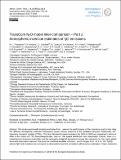TransCom N[subscript 2]O model inter-comparison – Part 2: Atmospheric inversion estimates of N[subscript 2]O emissions
Author(s)
Thompson, R. L.; Ishijima, K.; Corazza, M.; Karstens, U.; Patra, P. K.; Bergamaschi, P.; Chevallier, F.; Dlugokencky, E.; Weiss, R. F.; O'Doherty, Simon; Fraser, P. J.; Steele, L. P.; Krummel, P. B.; Vermeulen, A.; Tohjima, Y.; Jordan, Andres; Haszpra, L.; Steinbacher, M.; Van der Laan, S.; Aalto, T.; Meinhardt, F.; Popa, M. E.; Moncrieff, J.; Bousquet, P.; Saikawa, Eri; Prinn, Ronald G.; ... Show more Show less
DownloadThompson-2014-TransCom N2O model i.pdf (4.039Mb)
PUBLISHER_CC
Publisher with Creative Commons License
Creative Commons Attribution
Terms of use
Metadata
Show full item recordAbstract
This study examines N[subscript 2]O emission estimates from five different atmospheric inversion frameworks based on chemistry transport models (CTMs). The five frameworks differ in the choice of CTM, meteorological data, prior uncertainties and inversion method but use the same prior emissions and observation data set. The posterior modelled atmospheric N[subscript 2]O mole fractions are compared to observations to assess the performance of the inversions and to help diagnose problems in the modelled transport. Additionally, the mean emissions for 2006 to 2008 are compared in terms of the spatial distribution and seasonality. Overall, there is a good agreement among the inversions for the mean global total emission, which ranges from 16.1 to 18.7 TgN yr[superscript −1] and is consistent with previous estimates. Ocean emissions represent between 31 and 38% of the global total compared to widely varying previous estimates of 24 to 38%. Emissions from the northern mid- to high latitudes are likely to be more important, with a consistent shift in emissions from the tropics and subtropics to the mid- to high latitudes in the Northern Hemisphere; the emission ratio for 0–30° N to 30–90° N ranges from 1.5 to 1.9 compared with 2.9 to 3.0 in previous estimates. The largest discrepancies across inversions are seen for the regions of South and East Asia and for tropical and South America owing to the poor observational constraint for these areas and to considerable differences in the modelled transport, especially inter-hemispheric exchange rates and tropical convective mixing. Estimates of the seasonal cycle in N[subscript 2]O emissions are also sensitive to errors in modelled stratosphere-to-troposphere transport in the tropics and southern extratropics. Overall, the results show a convergence in the global and regional emissions compared to previous independent studies.
Date issued
2014-06Department
Massachusetts Institute of Technology. Center for Global Change ScienceJournal
Atmospheric Chemistry and Physics
Publisher
Copernicus GmbH
Citation
Thompson, R. L., K. Ishijima, E. Saikawa, M. Corazza, U. Karstens, P. K. Patra, P. Bergamaschi, et al. “TransCom N[subscript 2]O Model Inter-Comparison – Part 2: Atmospheric Inversion Estimates of N[subscript 2]O Emissions.” Atmospheric Chemistry and Physics 14, no. 12 (2014): 6177–6194.
Version: Final published version
ISSN
1680-7324
1680-7316